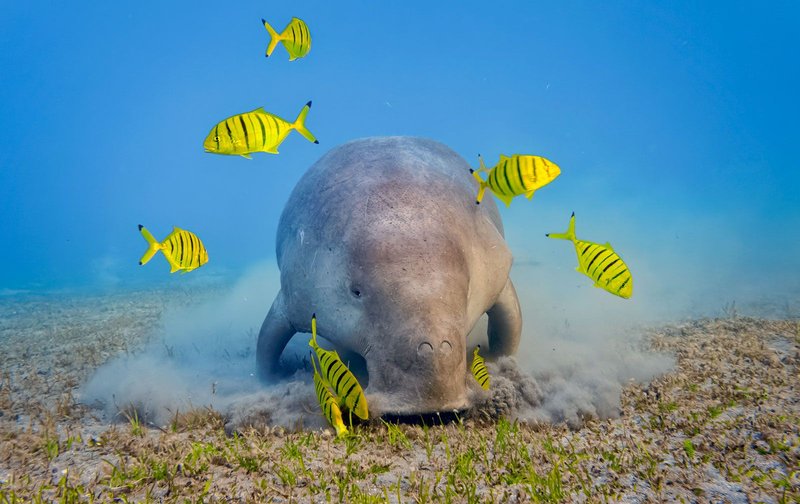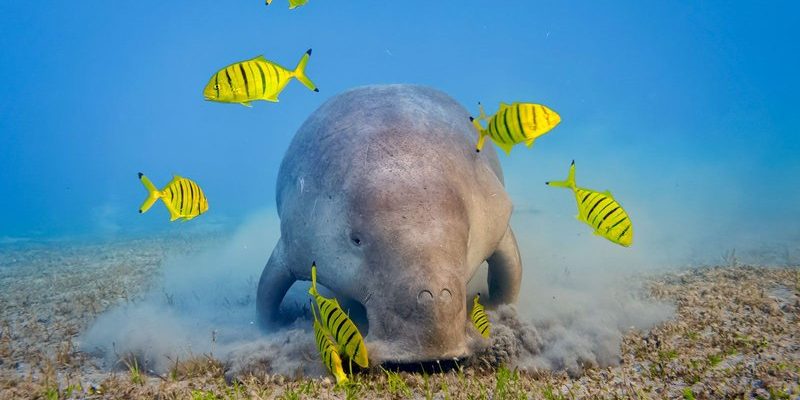
Imagine the underwater meadows where dugongs graze. They’re like the gardeners of the sea, munching on seagrass and influencing the whole ecosystem. Understanding the dugong’s role helps us appreciate the intricate web of life in our oceans. So, let’s dive in and explore what makes these remarkable creatures so essential.
What Is a Dugong and Where Do They Live?
Dugongs are fascinating marine mammals that belong to the order Sirenia, which also includes manatees. They are large, herbivorous creatures with a body shaped somewhat like a torpedo, and their unique, fluked tail helps them navigate through the warm coastal waters. Found primarily in warm waters from the Red Sea to Australia, the dugong spends most of its life in shallow waters where seagrass thrives.
These gentle giants can grow up to 10 feet long and weigh around 1,100 pounds. When you see them gliding gracefully underwater, it’s hard not to feel a sense of awe. Dugongs are often seen in small groups, but they can also be solitary. Their affinity for seagrass beds makes them key players in the ecosystems where they thrive.
The Importance of Seagrass Meadows
Seagrass meadows are more than just pretty underwater gardens—they’re vital ecosystems that support a wide variety of marine life. When dugongs feed on seagrass, they help to maintain the health of these meadows. Here’s how:
- Grazing Pressure: By munching on seagrass, dugongs prevent overgrowth. This helps maintain a balance in the ecosystem, allowing diverse species to thrive.
- Water Clarity: Healthy seagrass meadows filter the water, contributing to clearer waters, which benefits other marine creatures by allowing more sunlight to penetrate.
- Habitat for Other Species: Seagrass meadows provide shelter and food for many marine organisms, from tiny fish to larger predators.
So, every time a dugong nibbles on a tuft of seagrass, it’s not just satisfying its appetite; it’s playing a role in a much larger environmental play.
Dugongs and Nutrient Cycling
Here’s the thing—when dugongs munch on seagrass, they don’t just eat it and move on. Their feeding habits contribute significantly to nutrient cycling in the ocean.
As they graze, dugongs uproot seagrass, which releases nutrients back into the water. These nutrients promote the growth of phytoplankton and other microscopic organisms. This tiny life forms the foundation of the marine food web.
Moreover, dugong waste also contributes to nutrient cycling. Their droppings are packed with nutrients that fertilize the seagrass, encouraging more growth. This back-and-forth relationship creates a vibrant underwater ecosystem that supports everything from small fish to large predators.
The Dugong’s Role in Biodiversity
Biodiversity is crucial for resilient ecosystems, and dugongs help enhance this diversity in several ways. By ensuring the health of seagrass meadows, they indirectly support countless marine species.
For example, the presence of healthy seagrass beds attracts young fish, crabs, and invertebrates that rely on these habitats for shelter and food. So, you might say dugongs are like the unsung heroes, ensuring that their environment remains lively and diverse.
Additionally, a rich biodiversity helps maintain ecosystem stability. If one species declines, it can ripple through the entire system. Dugongs help mitigate this risk by supporting the health of their ecosystem, creating a buffer against environmental changes.
Threats to Dugongs and Their Habitats
Unfortunately, dugongs face numerous threats that endanger their populations and the ecosystems they support. Here are some challenges they encounter:
- Habitat Loss: Coastal development, pollution, and boat traffic destroy seagrass meadows, limiting the food supply for dugongs.
- Climate Change: Rising sea temperatures and ocean acidification can harm seagrass beds, impacting dugong populations.
- Fishing Practices: Bycatch in fishing nets and illegal hunting also pose significant risks to dugongs.
As their habitats shrink and their numbers dwindle, the delicate balance of the ecosystems they inhabit becomes increasingly fragile.
Conservation Efforts for Dugongs
The good news is that many organizations and governments are working hard to protect dugongs and their habitats. Conservation efforts focus on various strategies:
- Protecting Seagrass Beds: Establishing marine protected areas can safeguard critical habitats from development and pollution.
- Education and Awareness: By educating communities about the importance of dugongs, we can foster a sense of stewardship for their habitats.
- Legislation: Enforcing laws against illegal hunting and harmful fishing practices is essential for the survival of dugongs.
Together, these efforts can help ensure that dugongs continue playing their vital role in the marine ecosystem for generations to come.
How You Can Help
You might be wondering how you can contribute to the conservation of dugongs and their habitats. Here are a few simple ways to make a difference:
- Reduce Plastic Usage: Plastic waste can harm marine life. By cutting down on plastic, you help protect ocean habitats.
- Support Sustainable Seafood: Choose seafood that’s sustainably caught to help reduce bycatch and protect marine ecosystems.
- Engage with Local Conservation Groups: Volunteer or support organizations focused on marine conservation—your efforts can have a significant impact.
Even small changes in our daily lives can lead to big outcomes for dugongs and their ecosystems.
The dugong’s role in its ecosystem is truly remarkable. From maintaining healthy seagrass meadows to supporting biodiversity, these marine mammals are essential to the well-being of ocean environments. As we become more aware of their plight, it’s crucial to take action and support conservation efforts.
By understanding and appreciating the dugong, we can help ensure that these gentle giants continue to thrive in our oceans. Remember, every action counts, big or small. Together, we can help protect not just dugongs but the vibrant ecosystems they help sustain.

